A cylindrical capacitor consists of a hollow or a solid cylindrical conductor around a concentric hollow spherical cylinder. It can store a large amount of electric charge.
Capacitors are used to store a specific amount of charge and use that charge in an electric circuit. They usually have a small physical size but they are used for multiple electronic circuits. There are multiple capacitors in electronics that are used for different applications and purposes. In this article, we are going to study cylindrical capacitors in detail.
What is a Cylindrical Capacitor?
We can define a cylindrical capacitor as “A cylindrical capacitor is a tube or pipe shape like of electrical capacitor that consists of two or more conductive plates arranged in a cylindrical shape”. Inside the tube shape, they carry a solid conductive material to conduct electricity. Its inner part is surrounded by a hollow ball. These capacitors are concentric as both inner and outer hollow tubes have the same center.
After applying electricity positive and negative charges are set up in both the inner and outer tubes of the capacitor that eventually create an electric field in between them. It is designed to store and release charge by creating an electric fuel in between the conductive elements.
Construction of Cylindrical Capacitor
Basically in construction, cylindrical capacitors carry an inner conductive cylinder called the positive electrode and an outer conductive cylinder called the negative electrode. These cylinders are typically made up of metals kike copper or aluminum having cylindrical shapes.
Then we insert an insulator dielectric material between two cylinders. This insulating dielectric material does not allow electric current to flow through it but it allows the existence of an electric field across it. The common types of dielectric materials include ceramics, plastic films, or air used in a cylindrical capacitor.

The arrangement of conductive cylinders is concentric due to the same central axis. Then we add insulating support to ensure that both conductive plates do not touch each other. External terminals are also added to make connections with an external electric circuit in any application.
Finally, we enclosed them in a protective casing to protect them from environmental factors (in some specific cases).
Cylindrical Capacitor Formula
Following is the formula for calculating the cylindrical capacitor capacitance.
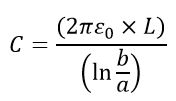
Where,
- C is the capacitance of a cylindrical capacitor.
- ε0 is the vacuum permittivity with a value round about 8.854 x 10-12 F/m (farads per meter).
- L is the length of the cylinder capacitor.
- a is the inner cylinder radius
- b is the outer cylinder radius
According to the above formula, capacitance depends on the size of the capacitor and the distance between the inner and outer cylinders. The larger capacitance value shows that the capacitor can store more electrical charge.
Derivation of Cylindrical Capacitor Formula
A cylindrical capacitor has a concentric cylindrical shell of radius b. It is enclosed by a conducting wire of radius a. Here b>a. The length of the cylinder is L.
When the capacitor is charged the inner cylinder holds +Q charge and the outer cylinder holds – Q charge.
To calculate the electric field between two conductors using Gauss’ law, consider a Gaussian surface with radius r and length L1.
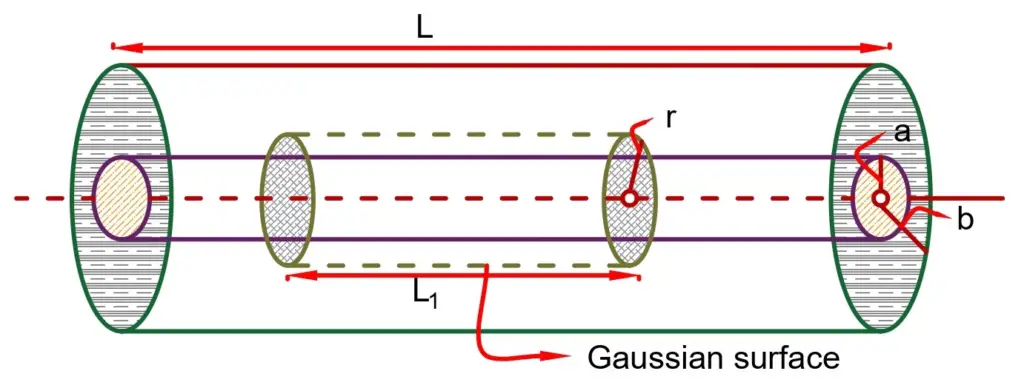
Flux across the surface according to Gauss’ law is;

Where q is the net charge inside the surface and A is the area of the cylinder.

Putting the value of equation(2) in equation(1), we get
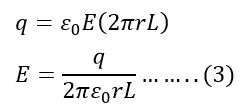
We know,

Putting the value of equation(3) in equation (4), we get;
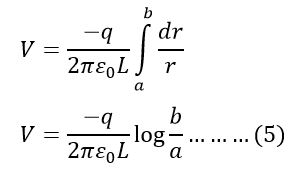
By rearranging equation(5),
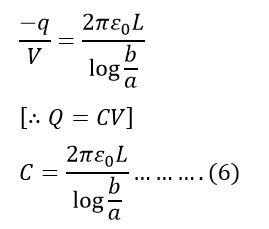
The above formula is for the calculation of the capacitance of a cylindrical capacitor.
Working of Cylindrical Capacitor
Initially, the capacitors will be uncharged (no electric charge stored). After connecting the capacitor to a power source (battery), the voltage will be applied to the terminals of conductive cylinders. Eventually, this voltage will develop an electric field between the two terminals.
As a result of applying voltage, electrons will move from one cylinder to another cylinder. Positive changes will be accumulated on the inner surface while the negative charges will move to the outer electrode.
These charges will create an electric field between the conductive electrodes and the dielectric material between the two electrodes. The electric field will cause polarization in the dielectric material. They will align with the external electric field and will strengthen will electric field effect.
Now the cylindrical capacitor will store the electric energy (potential) up to when the electric charge will continue to accumulate on the electrodes as the result of the polarization of the dielectric material. This is how capacitors will store useful electrical energy.
After disconnecting from the power source, there will be no electric field and polarization of the dielectric material. So now the capacitor will discharge its electrical energy in the electric circuit. This energy can be used to power electronic devices. This is how a cylindrical capacitor works.
Advantages of Cylindrical Capacitor
Here are following the advantages of cylindrical capacitors:
- Its process to store and deliver electric charge (energy) is fast.
- They often allow better thermal dissipation.
- They offer a large capacitance to store the electric charge.
- Less maintenance is required for them which ensures a large lifespan.
- Like other capacitors, they also offer large voltage ratings with their compact design.
Disadvantages of Cylindrical Capacitor
Here are some disadvantages of cylindrical capacitors:
- They have limited applications than other capacitors.
- They also have some degree of leakage current
- Their cost is high than other capacitors.
Applications of Cylindrical Capacitors
These are the applications that use cylindrical capacitors:
- They are used in motor start systems which require an initial push to start.
- For smoothing purposes, they are used in power supplies.
- They are used to separate different frequencies in the sound system to improve the sound.
- They are also used in radio frequency circuits and antennas.
- The cylindrical capacitors are part of voltage multiplier circuits that are used in high-voltage applications like X-ray generators and particle accelerators.
These are all applications where cylindrical capacitors are being used in the world of electronics.
Solved Examples
Numerical Example (1)
Suppose you have a cylindrical capacitor with an inner radius of 2 centimeters and an outer radius of 4 centimeters. The length of the cylindrical capacitor is 8 centimeters. Calculate the capacitance of the cylindrical capacitor with the dielectric permittivity of 5 × 10-9 F/m.
Solution-
Using the formula,

In this question,
L = 8cm
a = inner radius = 2cm
b = outer radius = 4cm
ε0= vacuum permittivity
= 8.85 x 10-12
Putting values in the formula,
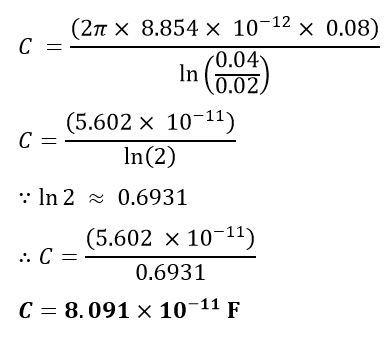
Numerical Example (2)
Consider a different cylindrical capacitor with an inner radius (a) of 3 millimeters and an outer radius (b) of 6 millimeters. The length of the cylindrical capacitor is 5 millimeters. The dielectric material used has a permittivity (ε) of 4 × 10^-9 F/m.
Solution-
Using the formula,

From the question,
L = 5mm
a = inner radius = 3mm
b = outer radius = 6mm
ε0= vacuum permittivity
=8.85×10-12
Putting values in the formula,
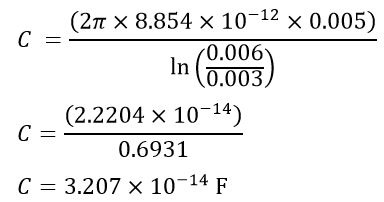
Conclusion
In conclusion, cylindrical capacitors are used to store and release electric charge in the world of electronics. These capacitors can store significant amounts of electrical energy, providing power smoothing, filtering, and voltage regulation functions in various devices. They carry two or more electrodes and a dielectric to separate the electrode. They store charge when connect to the supply and provide the electric charge when disconnected.